
Lolol is a Chilean commune and town in Colchagua Province, O'Higgins Region.

Santa Cruz is a Chilean city and commune, located in the Colchagua valley, in the O'Higgins Region, located on the southern shore of the Tinguiririca river, 110 miles from Santiago, Chile's capital city, and 27 miles from San Fernando.

Agustín Ross Cultural Centre, previously known as Casino Ross, is the cultural center of the city of Pichilemu in Libertador General Bernardo O'Higgins Region, Chile. It was constructed between 1906 and 1909 at the request of politician Agustín Ross Edwards. The structure of the cultural center is very similar to that of the Grand Trianon in Versailles, France.
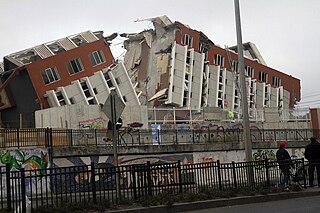
The 2010 Chile earthquake and tsunami occurred off the coast of central Chile on Saturday, 27 February at 03:34:12 local time, having a magnitude of 8.8 on the moment magnitude scale, with intense shaking lasting for about three minutes. It was felt strongly in six Chilean regions that together make up about 80 percent of the country's population. According to the United States Geological Survey (USGS) the cities experiencing the strongest shaking—VIII (Severe) on the Mercalli intensity scale (MM)—were Concepción, Arauco, and Coronel. According to Chile's Seismological Service, Concepción experienced the strongest shaking at MM IX (Violent). The earthquake was felt in the capital Santiago at MM VII or MM VIII. Tremors were felt in many Argentine cities, including Buenos Aires, Córdoba, Mendoza, and La Rioja. Tremors were felt as far north as the city of Ica in southern Peru. It is the largest earthquake to hit Chile since the 1960 Valdivia earthquake.

Agustín Ross Park is a park located in the Agustín Ross Avenue, in front of the old Ross Casino, in Pichilemu. It is a National Monument of Chile.

The Ross Balcony is a balcony constructed by Agustín Ross Edwards in 1910. It is located over rocks in the southern part of the beach of Pichilemu, in the Paseo de la Juventud. The waves came up to the balcony until the 1960 Valdivia earthquake.
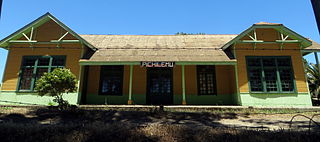
Estación Pichilemu, also known as the Estación de Ferrocarriles de Pichilemu was a railway station in Pichilemu, Chile. It is a wood construction dated c. 1925, located in front of the Petrel Lake, near Daniel Ortúzar Avenue. It remained in operation until the 1990s, and became a National Monument on September 16, 1994. It has since become an arts and culture center, and tourism information office. It exhibits decorative and practical objects from the 1920s, and features many old suits.

Colegio de la Preciosa Sangre de Pichilemu, often shortened to Preciosa Sangre, is a coeducational Roman Catholic private state-subsidized day school, serving students in preschool through twelfth grade, located in the commune of Pichilemu, Libertador General Bernardo O'Higgins Region, Chile.

The history of Pichilemu began around the 16th century, when Promaucaes inhabited the modern Pichilemu region. According to Chilean historiographer José Toribio Medina on his book Los Restos Indígenas de Pichilemu (1908), Spanish conqueror Pedro de Valdivia gave Topocalma encomienda, in which Pichilemu was supposed to be, to Juan Gómez de Almagro, on January 24, 1544.

The Mayor of Pichilemu is an elected politician who is the head of the executive branch of government of the commune of Pichilemu, Libertador General Bernardo O'Higgins Region, Chile. The mayor presides over the local city council, composed of six members, and serves as the civic representative of the commune. The mayor is popularly elected in a municipal election, by simple majority. The office is held for a four-year term without term limits.

The Pichilemu City Council is the legislative body of the City of Pichilemu. The council meets in Pichilemu City Hall.

José María Caro Martínez was a Chilean politician and civil servant. In May 1894, he was unanimously elected as the first mayor of the commune of Pichilemu, with Pedro Nolasco de Mira and Francisco Reyes made second and third magistrate respectively. Caro Martínez had previously served for several years as administrator or llavero of the San Antonio de Petrel hacienda and, between 1891 and 1892, was the Subdelegate of the 13th Subdelegation of San Fernando Department which comprised the district of Cáhuil.
The 1985 Rapel Lake earthquake occurred on 8 April at with a moment magnitude of 7.2 and a maximum perceived intensity of VI (Strong). The shock was centered 75 kilometres (47 mi) southwest of Santiago, Chile, with a focal depth of 37.8 km (23 mi).
The Pichilemu Fault, also referred to as the Pichilemu-Vichuquén Fault, is a Chilean geological fault, located in Libertador General Bernardo O'Higgins Region, some kilometers away from Pichilemu, at a depth of 15 kilometres (9.3 mi). The fault is 40 kilometres (25 mi) long and 20 kilometres (12 mi) wide.
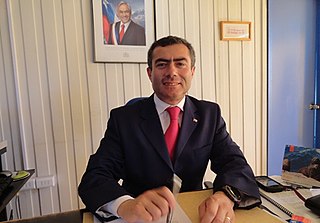
Julio Diego Ibarra Maldonado is a Chilean politician. Ibarra was the Governor of Cardenal Caro Province since he was appointed by President of Chile Sebastián Piñera on March 16, 2010. He left office on March 12, 2014.

The 2010 Pichilemu earthquakes, also known as the Libertador O'Higgins earthquakes, were a pair of intraplate earthquakes measuring 6.9 and 7.0 that struck Chile's O'Higgins Region on 11 March 2010 about 16 minutes apart. The earthquakes were centred 15 kilometres (9.3 mi) northwest of the city of Pichilemu.
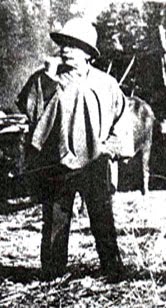
Daniel Ortúzar Cuevas was a Chilean politician, who served as a deputy for San Fernando between 1891 and 1903, and deputy for Caupolicán —current Rengo— between 1903 and 1906.
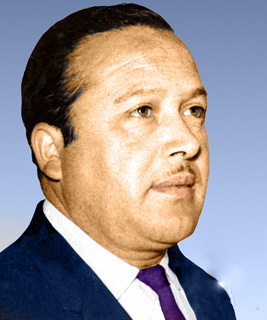
Washington Saldías Fuentealba was the 29th Mayor of the Chilean commune of Pichilemu, office which he held between May 1971 and September 1973: his term was interrupted by the 1973 Chilean coup d'état, which put General Augusto Pinochet in the power of the country, and who later appointed Carlos Echazarreta Iñiguez as the successor of Saldías. Saldías was also regidor of the commune of Pichilemu between 1963 and 1971, and a founding member of the Club Aéreo de Pichilemu.
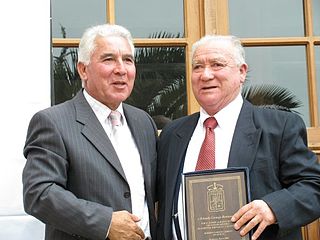
Orlando Cornejo Bustamante was the 37th Mayor of the commune of Pichilemu, office which he held between September 1992 and December 1996, representing the Union of the Centrist Center (UCC). He was the first mayor of Pichilemu to be elected following the Chilean transition to democracy. In 1996 and 2000, he ran again as a candidate in the municipal elections of these years, but failed to be elected in either.

Pichilemu, originally known as Pichilemo, is a beach resort city and commune in central Chile, and capital of Cardenal Caro Province in the O'Higgins Region. The commune comprises an urban centre and twenty-two villages, including Ciruelos, Cáhuil, and Cardonal de Panilonco. It is located southwest of Santiago. Pichilemu had over 13,000 residents as of 2012.


















